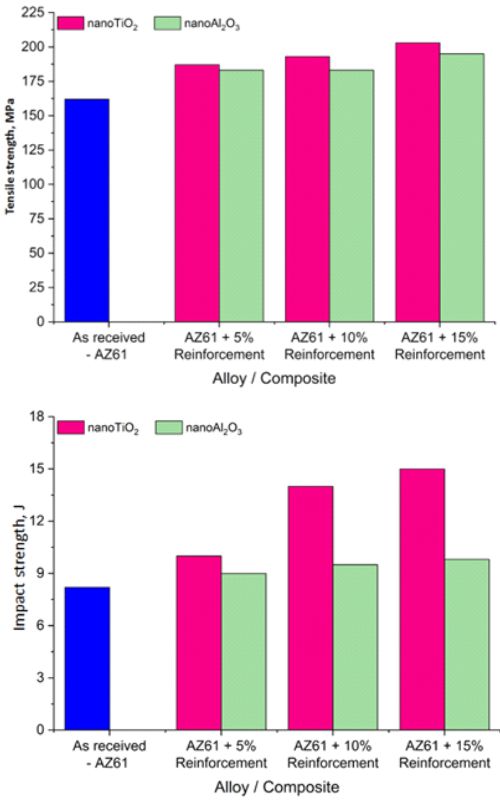Mechanical properties of surface-modified magnesium alloy AZ61 with nanoparticles of aluminum oxide and titanium dioxide by friction stir processing Technical paper
Main Article Content
Abstract
The present work investigates the mechanical properties of surface-modified magnesium alloy AZ61 reinforced with Al2O3 and TiO2 nanoparticles by using the friction stir processing (FSP) technique. Surface-modified AZ61 alloys were fabricated by the addition of dufferent amount of Al2O3 and TiO2 nanoparticles (5, 10, and 15 vol.%). The developed surface composites were studied regarding microstructure, revealing a uniform dispersion of the added nanoparticles, which resulted in improved mechanical properties of the obtained composites by FSP. The ultimate tensile strength, impact strength, and microhardness improved by 20, 45, and 67 % by reinforcing the alloy with nanoTiO2 particles when compared to the as-cast alloy. The results of this study indicate that the reinforced AZ61 Mg alloy can be a potential material for applications in automobile sectors due to its high strength and lightweight components.
Article Details
Issue
Section

This work is licensed under a Creative Commons Attribution-NonCommercial-NoDerivatives 4.0 International License.
Authors who publish with this journal agree to the following terms:
Authors retain copyright and grant the journal right of first publication with the work simultaneously licensed under a Creative Commons Attribution License that allows others to share the work with an acknowledgement of the work's authorship and initial publication in this journal.
Authors grant to the Publisher the following rights to the manuscript, including any supplemental material, and any parts, extracts or elements thereof:
- the right to reproduce and distribute the Manuscript in printed form, including print-on-demand;
- the right to produce prepublications, reprints, and special editions of the Manuscript;
- the right to translate the Manuscript into other languages;
- the right to reproduce the Manuscript using photomechanical or similar means including, but not limited to photocopy, and the right to distribute these reproductions;
- the right to reproduce and distribute the Manuscript electronically or optically on any and all data carriers or storage media – especially in machine readable/digitalized form on data carriers such as hard drive, CD-Rom, DVD, Blu-ray Disc (BD), Mini-Disk, data tape – and the right to reproduce and distribute the Article via these data carriers;
- the right to store the Manuscript in databases, including online databases, and the right of transmission of the Manuscript in all technical systems and modes;
- the right to make the Manuscript available to the public or to closed user groups on individual demand, for use on monitors or other readers (including e-books), and in printable form for the user, either via the internet, other online services, or via internal or external networks.
How to Cite
References
Huang, S.J, Subramani, M, Chiang, CC. Effect of hybrid reinforcement on microstructure and mechanical properties of AZ61 magnesium alloy processed by stir casting method.Compos Commun. 2021; 25: 100772. https://doi.org/10.1016/j.coco.2021.100772
Billard, A., Maury, F., Aubry, P., Balbaud-Célérier, F., Bernard, B., Lomello, F., Maskrot, H., Meillot, E., Michau, A. and Schuster, F. Emerging processes for metallurgical coatings and thin films. CR Phys. 2018: 19; 755-768.https://doi.org/10.1016/j.crhy.2018.10.005
Mahoney MW, Binget WH, Mishra RS. Microstructural Modification and Resultant Properties of Friction Stir Processed Cast NiAl Bronze. Mater Sci Forum. 2003; 426: 2843-2853. https://doi.org/10.4028/www.scientific.net/MSF.426-432.2843
Ammouri A H, Kridli G, Ayoub G, Hamade RF. Relating grain size to the Zener–Hollomon parameter for twin-roll-cast AZ31B alloy refined by friction stir processing. J Mater Process Technol. 2015; 222: 301-306.https://doi.org/10.1016/j.jmatprotec.2015.02.037
Xue P, Xiao BL, Ma ZY. Enhanced strength and ductility of friction stir processed Cu–Al alloys with abundant twin boundaries.Scr Mater. 2013; 68: 751-754. https://doi.org/10.1016/j.scriptamat.2013.01.003
Chai F, Zhang D, Li Y, Microstructures and tensile properties of submerged friction stir processed AZ91 magnesium alloy. J Magnes Alloy. 2015; 3: 203–209. https://doi.org/10.1016/j.jma.2015.08.001
Patel V, Li W, Vairis A, Badheka V. Recent development in friction stir processing as a solid-state grain refinement technique: microstructural evolution and property enhancement.Crit Rev Solid State Mater Sci. 2019; 44: 378-426. https://doi.org/10.1080/10408436.2018.1490251
Satish Kumar T, Shalini S, Thankachan T. Friction stir processing based surface modification of AZ31 magnesium alloy. Mater Manuf Process. 2023; 38(11): 1426-1435. https://doi.org/10.1080/10426914.2023.2165670
Aatthisugan I, Rose AR, Jebadurai DS. Mechanical and wear behaviour of AZ91D magnesium matrix hybrid composite reinforced with boron carbide and graphite.J Magnes Alloy. 2017; 5: 20-25. https://doi.org/10.1016/j.jma.2016.12.004
Balaji E, Sathiya Moorthy R. Investigation on Mechanical and Wear Properties of ZE43 Magnesium Composites Reinforced with Silicon Nitride by Friction Stir Processing. Silicon. 2022; 6: 11881-11890. https://doi.org/10.1007/s12633-022-01914-1
Sagar P, Handa A, Kumar G. Metallurgical, mechanical and tribological behavior of Reinforced magnesium-based composite developed Via Friction stir processing. Proc Inst Mech Eng E: 2022; 236: 1440-1451. https://doi.org/10.1177/09544089211063099
Adetunla A, Akinlabi E. Influence of reinforcements in friction stir processed magnesium alloys: insight in medical applications. Mater Res Express. 2018; 6: 025406. https://doi.org/10.1088/2053-1591/aaeea8
Gobara M, Shamekh M, Akid R. Improving the corrosion resistance of AZ91D magnesium alloy through reinforcement with titanium carbides and borides. J Magnes Alloy. 2015; 39: 112-120. https://doi.org/10.1016/j.jma.2015.03.002
Gangil N, Nagar H, Mohammed SMAK, Singh D, Siddiquee AN, Maheshwari S, Chen DL. Fabrication of magnesium–NiTip composites via friction stir processing: Effect of tool profile. Metals. 2020; 10: 1425. https://doi.org/10.3390/met10111425
Dinaharan I, Zhang S, Chen G, Shi Q. Titanium particulate reinforced AZ31 magnesium matrix composites with improved ductil¬ity prepared using friction stir processing. Mater Sci Eng. 2020; 772: 138793. https://doi.org/10.1016/j.msea.2019.138793
Das U, Toppo V. Effect of Tool Rotational Speed on Temperature and Impact. Mater Today Proc. 2018; 5: 6170-6175. https://doi.org/10.1016/j.matpr.2017.12.223
Thirumalvalavan S, Senthilkumar N, Experimental Investigation and Optimization of HVOF Spray parameters on wear resistance behaviour of Ti-6Al-4V Alloy, ,C R Acad Bulg Sci.2019; 72: 665-674. https://doi.org/10.7546/CRABS.2019.05.15





